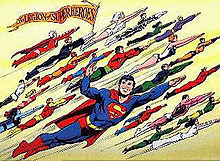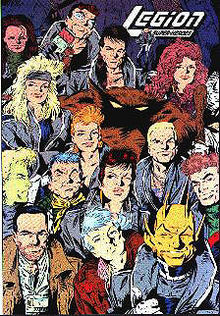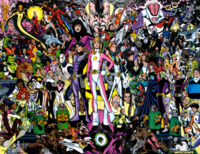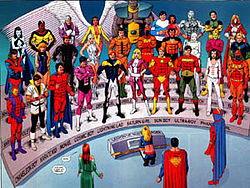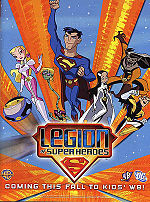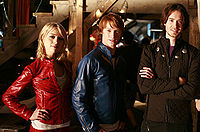- Legion of Super-Heroes
-
Legion of Super-Heroes 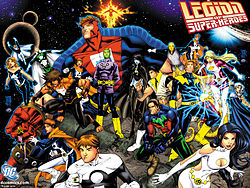
Cover for Legion of Super-Heroes (vol. 5) #37.
Art by Francis Manapul and John Livesay.Publication information Publisher DC Comics First appearance (Original)
Adventure Comics #247 (April, 1958)
(Reboot)
Legion of Super-Heroes (vol. 4) #0 (October, 1994)
(Threeboot)
Teen Titans/Legion Special (November, 2004)
(Post-Infinite Crisis)
Justice League of America (vol. 2) #8 (April, 2007)Created by Otto Binder
Al PlastinoIn-story information Base(s) Legion Clubhouse
Legion Outpost
Legion WorldRoster See:List of Legion of Super-Heroes members The Legion of Super-Heroes is a fictional superhero team in the 30th and 31st centuries of the DC Comics Universe. The team first appears in Adventure Comics #247 (April 1958), and was created by Otto Binder and Al Plastino.
Initially, the team was closely associated with the original Superboy (Superman when he was a teenager), and was first portrayed as a group of time travelers who frequently visited him. In later years, the Legion's origin and back story were fleshed out, and the group replaced Superboy as the focus of their stories; eventually Superboy was removed altogether, except as an occasional guest star.
The team has undergone several major reboots during its publication. The original version was replaced with a new rebooted version following the events of Zero Hour and another rebooted team was introduced in 2004. A fourth version of the team, nearly identical to the original version, was introduced in 2007. As a result, Superman (both as an adult and a teenager) and the current version of Supergirl have been reincorporated into Legion history.
Contents
Publication history
Original continuity (1958–1994)
Main article: Legion of Super-Heroes (1958 team)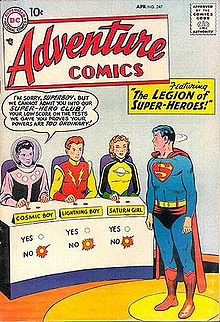 The cover of Adventure Comics #247 (April 1958), the Legion's first appearance. Art by Curt Swan and Stan Kaye.
The cover of Adventure Comics #247 (April 1958), the Legion's first appearance. Art by Curt Swan and Stan Kaye.
Superboy was the featured series in Adventure Comics in the late 1950s. In Adventure Comics #247 (April 1958), he was met by three teenagers from the 30th century: Lightning Boy, Saturn Girl, and Cosmic Boy, who were members of a "super-hero club" called the Legion of Super-Heroes. Their club had been formed with Superboy as an inspiration, and they had time travelled to recruit Superboy as a member. After a series of tests, Superboy was awarded membership and returned to his own time.
Although intended as a one-off story focusing on Superboy, the Legion proved so popular that it returned for an encore in Adventure Comics #267 (December 1959). Lightning Boy had been renamed Lightning Lad, and their costumes were very close to those they wore throughout the Silver Age of Comic Books. The Legion's popularity grew, and they appeared in further stories in Adventure Comics and Action Comics over the next few years. The ranks of the Legion, only hinted at in those first two stories, were filled with new heroes, such as Chameleon Boy, Invisible Kid, Colossal Boy, Star Boy, Brainiac 5, Triplicate Girl, Shrinking Violet, Sun Boy, Bouncing Boy, Phantom Girl, and Ultra Boy. Even Supergirl was recruited as a member.[1]
In Adventure Comics #300 (September 1962), the Legion received their own regular feature, cover-billed "Superboy in 'Tales of the Legion of Super-Heroes'". While they would share space with Superboy solo stories for a couple of years, they eventually displaced Superboy entirely as their popularity grew.
It was this run which established the Legion's general workings and environment. A club of teenagers, they operated out of a clubhouse in the shape of a yellow rocket ship inverted as if it had been driven into the ground. The position of Legion leader rotated among the membership, sometimes through election, and sometimes by more arcane methods. Each Legionnaire had to possess at least one natural superpower (i.e., powers from devices were disallowed), in particular a power which no other member possessed. Despite this, several members had overlapping powers, particularly Superboy, Supergirl, Mon-El, and Ultra Boy. Some issues included comical moments where candidates with bizarre, useless, or dangerous abilities would try out for membership and be rejected. Five of these flawed candidates went on to form the Legion of Substitute Heroes. The Legion was based on Earth, and protected an organization of humans and aliens called the United Planets. The regular police force in the UP was the Science Police. The setting for each story was almost always 1000 years from the date of publication.
In Adventure Comics #346 (July 1966), Jim Shooter, 14-years-old at the time, wrote his first Legion story.[2] Soon thereafter, Shooter became the regular writer of the Legion stories, with Curt Swan, and later Win Mortimer, as artist. Shooter wrote the story about Ferro Lad's death— the first "real" death of a Legionnaire (although Lightning Lad had been believed dead for a while before) — and introduced many other enduring concepts, including the Fatal Five, Shadow Lass, the Dark Circle, Mordru, and the "Adult Legion", a conjecture regarding what the Legionnaires would be like when they grew up.
The Legion's last appearance in Adventure Comics was #380 (May 1969), when they were displaced by Supergirl. The early 1970s saw the Legion relegated to the status of back-up feature. First, the team's stories were moved to Action Comics for issues #377–392 (June 1969–September 1970). Following that, the Legion began appearing occasionally as a backup in Superboy, starting with #172 (March 1971), with writer and artists E. Nelson Bridwell, Cary Bates, and George Tuska. Dave Cockrum began drawing the series with Superboy #184 (April 1972), again increasing the team's popularity.[3]
Superboy and their own title
The first comic book published under the title Legion of Super-Heroes was a four-issue series published in 1973 that reprinted Legion tales from Adventure Comics. In the same year, the Legion returned to cover billing on a book when Superboy became Superboy starring the Legion of Super-Heroes with #197 (August 1973). Crafted by Bates and Cockrum, the feature proved popular and saw such events as the wedding of Bouncing Boy and Duo Damsel.[4] Cockrum was replaced on art by Mike Grell as of issue #203 (August 1974) which featured the death of Invisible Kid.[5] With #231 (September 1977), the book's title officially changed to Superboy and the Legion of Super-Heroes and also became a "giant-size" title. At this point, the book was written by longtime fan Paul Levitz and drawn by James Sherman, although Gerry Conway frequently wrote as well. In #241–245 (July–December 1978) Levitz and Sherman (and then Joe Staton) produced what was at that time the most ambitious Legion storyline: "Earthwar", a galactic war between the United Planets and the Khunds, with several other villains lurking in the background. During this period, Karate Kid was spun off into his own 20th Century-based self-titled series, which lasted 15 issues. Levitz left the book, to be replaced full-time by Gerry Conway.
Superboy departed from the Legion due to a plot of a villain, and the book was renamed simply Legion of Super-Heroes starting with issue #259 (January 1980). Jimmy Janes took over the art in a lengthy tale by Conway (and later Roy Thomas) involving Ultra Boy's disappearance during a mission, and his long odyssey to rejoin the team.[6] This story told the tale of the Legionnaire Reflecto (only glimpsed during the "Adult Legion" stories in Adventure Comics), featured villainy by the Time Trapper and Grimbor the Chainsman, and saw Superboy rejoin the team.[7]
Paul Levitz era
Paul Levitz returned to write the book with #284. Pat Broderick and Bruce Patterson illustrated the book for a short time before Keith Giffen began on pencils, with Patterson, and then Larry Mahlstedt, on inks. The creative team received enhanced popularity following "The Great Darkness Saga",[8] which ran from #287; #290–294; and Annual #3, featuring a full assault on the United Planets by Darkseid.
The Legion celebrated issue #300 (June 1983) by revisiting the "Adult Legion" storyline through a series of parallel world short stories illustrated by a number of popular Legion artists from previous years. The story served to free up Legion continuity from following the "Adult Legion" edict of previous issues. Giffen's style changed abruptly a few issues later, to a darker and sketchier style inspired by Argentinian artist José Muñoz. A new Legion of Super-Heroes comic (the third publication under the title) was launched in August 1984. The existing Legion series, renamed Tales of the Legion of Super-Heroes with issue #314, continued running new material for a year, then began reprinting stories from the new Legion of Super-Heroes with issue #326. Tales continued publishing reprints until its final issue, #354 (December 1987).
The new series was launched in August 1984 with a five-part story featuring the Legion of Super-Villains. Giffen left in the middle of the story and was replaced by Steve Lightle, who stayed on the book for a year. Greg LaRocque began a lengthy run in #16 (November 1985), including a crossover with John Byrne's recently-rebooted Superman titles in #37 and #38. The crossover was the first of several attempts by DC editors to explain the origins and fate of Superboy and his history with the Legion, in light of the revisions to the DC Universe caused by Crisis on Infinite Earths that removed Superman's career as Superboy from his personal history. In the crossover, the Legion's Superboy was revealed to have come from a parallel "Pocket Universe" created by the Time Trapper.[9] The crossover ended with Superboy's death. Levitz's run ended with the return of Giffen and a four-part story, concluding in #63 (August 1989).
"Five Years Later"
Giffen took over plotting as well as penciling with the Legion of Super-Heroes volume 4 title which started in November 1989, with scripts by Tom and Mary Bierbaum and assists by Al Gordon.[10] Five years after the Magic Wars, the United Planets is a darker place and the Legion a distant memory. However, a group of former Legionnaires worked to re-form the Legion in this harsh new universe, in which Earth was ruled by the alien Dominators.
Shortly after this storyline began, the decision was made to retroactively remove Superboy completely from Legion history, leaving the question of where the Legion's inspiration came from without the influence of Superboy. The writers' solution was a massive retcon, in which Mon-El served in the role of paragon, with several more retcons to follow. Issue 5 featured an alternate universe story in which the restructuring took place, and the Time Trapper was replaced in continuity by his onetime underling Glorith. Giffen skipped plotting on several issues which resulted in the Bierbaums writing several fill-in stories.
One major storyline during this period was the discovery of Batch SW6, a group of time-paradox duplicates of the early Legion, circa their Adventure Comics days. Keith Giffen's original intention for the storyline was that the clones would have eventually been revealed to be the real Legion, and the ones whose adventures had been chronicled since the 1950s were actually the clones. The adult Legion's secret programming would kick in, forcing them to fight the younger Legion and leading to a fight to the death with the victims names being picked at random out of a hat. Afterwards, the older team would explore the Vega System as a 30th century version of the Omega Men while the younger team would act as the main Legion on Earth. Giffen's other ending was for several of the younger and older Legionnaires to die while liberating Earth from the Dominion. The older Legion would defend Earth while the younger Legion would act as the last line of denfense for the United Planets as the Omega Men.[11] Instead, a parallel title, Legionnaires, was launched, starring the "SW6" Legion, whose origins were not resolved until the Zero Hour crossover by a different writing team. Legionnaires was lighter in tone than the main Legion book, and was written by the Bierbaums and drawn by Chris Sprouse. Giffen left the book after a storyline which involved the destruction of Earth,[12] and the Bierbaums continued writing, overseeing the return of several classic characters. When the Bierbaums left, writer Tom McCraw took over and made a number of changes, such as forcing several Legion members underground, which required them to take on new identities and costumes, and bringing back long-absent Legionnaire Wildfire.
In 1994, DC editors decided that after 36 years, the team's continuity would be entirely rebooted. As part of the Zero Hour company-wide crossover, the Legion's original continuity came to an end with Legion of Super-Heroes (vol. 4) #61 (September 1994).
Rebooted (1994–2004)
Main article: Legion of Super-Heroes (1994 team)Following Zero Hour, a new Legion continuity was created, beginning with a retelling of the origin story starting in Legion of Super-Heroes (vol. 5) #0 and then continued in spin-off sister series Legionnaires #0 (both released in October 1994). Lightning Lad was renamed Live Wire, and after the group's founding, a large number of heroes were added to the roster very quickly. Several members were given new code-names, and some new heroes were added, including XS (the granddaughter of Barry Allen, the Flash), Kinetix, and Gates.
While in some ways following the pattern of the original continuity, the new continuity diverged from the old one in several ways: some characters died as they had previously, others did not, and some Legion members spent time in the 20th century where they recruited Ferro. The Legion also started out having to earn the respect of the United Planets, which they did through two well-earned victories: successfully defending Earth from the White Triangle Daxamites, a group of Nazi-style racial purists; and exposing United Planets President Chu as the mastermind behind the Braal-Titan War, the Sun Eater hoax, the formation of the Fatal Five and the brainwashing of future Legionnaire Jan Arrah.[13]
New writers Dan Abnett and Andy Lanning (nicknamed "DnA" by fans) came on board with penciller Olivier Coipel to produce a dark story leading to the near-collapse of the United Planets and of the Legion itself. In the wake of the disaster, a group of Legionnaires disappeared through a spatial rift and the two existing Legion series came to an end. The limited series Legion Lost (2000–2001) chronicled the difficult journey of these Legionnaires to return home, while the ensuing limited series Legion Worlds (2001) showed what was happening back in the United Planets during their absence.
A new series, The Legion, was launched in which the Legion was reunited and given a new base and purpose. Written for its first 33 issues by DnA, the series was cancelled with issue 38. The most notable addition to the team during the title's publication was the post-"Crisis" Superboy, a 21st century clone of Superman and Lex Luthor who had previously been granted honorary membership.
"Threeboot" continuity (2004–2009)
Main article: Legion of Super-Heroes (2004 team)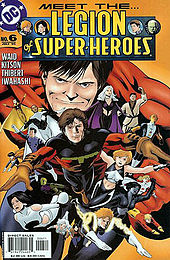 The cover of The Legion of Super-Heroes (vol. 5) #6 (July 2005), featuring the "Threeboot" Legionnaires. Art by Barry Kitson.
The cover of The Legion of Super-Heroes (vol. 5) #6 (July 2005), featuring the "Threeboot" Legionnaires. Art by Barry Kitson.
Following a crossover with the Teen Titans in Teen Titans #16 and the Teen Titans/Legion Special, a new series was launched; written by Mark Waid (who had previously rebooted the title following the events of Zero Hour) and penciled by Barry Kitson. This new series — the fifth series entitled Legion of Super-Heroes — recreated the team from the ground up and uses the Boy/Lad/Girl/Lass/Kid names from which the end of the "Preboot" era and the prior reboot had moved away from using. The continuity is sometimes referred to as the "Threeboot" continuity by fans as it is the third incarnation of the Legion that has been published since 1958.[citation needed]
Initial issues of the current title reintroduced the characters and provided new and divergent origins for them. Most characters resemble their previous counterparts in costume and powers, with the most notable exceptions including Chameleon Boy, now called simply Chameleon and depicted as an androgynous creature, Star Boy, who in this version of the Legion is black, Colossal Boy, who is now a giant who shrinks to human size, and Phantom Girl, who exists in two universes at once and has conversations with people in her own dimension while talking to Legionnaires at the same time.
The future universe of this Legion is an emotionally and mentally repressive society which involves human sexuality and contact being kept at arms' length as well as Orwellian surveillance of minors. The Legion's main goal is social reform as well as protecting people and inspiring them with the legends of superheroes of old, even though the team isn't appreciated by various government authorities.
The Legion is worshiped by thousands of "Legionnaires"; young people on various different worlds who worship the group in a cult-like manner. Some of the Legionnaires keep a constant vigil outside Legion headquarters.
Beginning with issue #16, The Legion of Super-Heroes (vol. 5) was retitled Supergirl and the Legion of Super-Heroes with Supergirl traveling to the future and joining the Legion. With issue #31, Tony Bedard replaced Waid as writer. The title reverted to The Legion of Super-Heroes with issue #37 and Jim Shooter became writer. The series ended with issue #50, in which the script was credited to "Justin Thyme", a pseudonym previously used by uncredited comic book artists.[14]
Post-Infinite Crisis (2007–present)
See also: Legion of Super-Heroes (1958 team) #Post-Infinite CrisisThe "Lightning Saga" crossover in Justice League of America (vol. 2) #8-10 and Justice Society of America (vol. 3) #5-6 featured the return of the original versions of Star Boy (now called Starman), Dream Girl, Wildfire, Karate Kid, Timber Wolf, Sensor Girl, Dawnstar, and Brainiac 5.[15] Though several differences between the original and Lightning Saga Legions exist, Geoff Johns stated that this incarnation of the Legion shares the same history as the original Legion up to the events of Crisis on Infinite Earths,[16] with Clark Kent having joined the team as the teenage Superboy prior to the start of his career as Superman.[17][18]
This version of the Legion next appeared in the "Superman and the Legion of Super-Heroes" storyline in Action Comics #858-863. In the year 3008, the Earth's sun has turned red and several failed Legion applicants who were born on Earth have banded together to form the Justice League of Earth under the leadership of Earth-Man after he claims that Superman was a human who gained his powers from "Mother Earth". Earth-Man uses the claim to have Earth secede from the United Planets and ban all aliens from Earth, resulting in several Legionnaires going underground. With the help of Superman, the Legion eventually restores the Sun to its normal state and defeats Earth-Man and the Justice League of Earth just as the United Planets is about to attack the Earth.[19]
This version of the Legion next appeared in the 2008 Final Crisis: Legion of 3 Worlds limited series, written by Geoff Johns and drawn by George Pérez. The mini-series features the post-Infinite Crisis Legion and Superman teaming up with the "Reboot" and "Threeboot" incarnations of the Legion to fight Superboy-Prime, the Legion of Super-Villains, and the Time Trapper.[20] It was revealed in the mini-series that the "Reboot" Legion came from Earth-247,[21] which was destroyed in Infinite Crisis, and the "Threeboot" Legion came from the reconstructed Earth-Prime. Geoff Johns stated that the intent of the mini-series was to validate the existence of all three versions of the team while simultaneously restoring the pre-Crisis Legion's continuity as well.[22] The incorporation of the three teams into mainstream DC continuity was also shown in Action Comics #864 (June 2008). In the story, Batman recounts the JLA and JSA's battle alongside the original Legion to defeat Mordru,[23] the "Reboot" team's assistance in destroying a Sun-Eater in the 20th century,[24] and his own recent encounter with the "Threeboot" team.[25]
As of September 2009[update], the post-Infinite Crisis version of the Legion is featured in the Adventure Comics ongoing series, currently in its second volume; in 2011, the stories featured the Legion Academy. This Legion also played a part in the "Superman: Last Stand of New Krypton" storyline in 2010, where the on-going continual events of "The Lightning Saga" concluded in its entirety.[26] A new Legion of Super-Heroes ongoing series started in 2010, written by Paul Levitz and drawn by Yildiray Cinar, featuring the post-Infinite Crisis version of the team.[27]
Relaunch
Legion of Super-Heroes was relaunched in September 2011 with issue #1, along with a new spin-off called Legion Lost.[28]
While Legion of Super-Heroes continues the adventures of the team from the previous volume, Legion Lost features Wildfire, Dawnstar, Timber Wolf, Tyroc, Tellus, Gates, and Chameleon Girl stranded in the 21st Century on a mission to save the future; however, they must remain there after they fear they have contracted a pathogen that could destroy the 31st century if they return.
Publications
Main article: List of Legion of Super-Heroes publicationsMembers
Alternative versions
Various alternative versions of the Legion of Super-Heroes have appeared in various DC comic books.
- The Legion of Super-Heroes appeared in a single panel in the Kingdom Come limited series.[29] The world depicted within Kingdom Come has been established as being Earth-22 in the DC Multiverse. This version of the team appears again briefly, in the closing pages of a story arc detailing the Earth-22 Superman's sojourn with the Justice Society of America in the 21st century (of Earth-0).[30]
- An alternative version of the Legion appeared in Legionnaires Annual #1 in 1994. The annual, which was part of the 1994 "Elseworlds Annuals" event, featured a version of the Legion based on King Arthur's court.
- Legion of Super-Heroes Annual #5, also published in 1994, featured the Legion in a parody of The Wizard of Oz.
- Legion of Super-Heroes Annual #7, part of the 1996 "Legends of Dead Earth" event, showed Wildfire as the last survivor of the original Legion, forming a new team.
- The "DC One Million" event, which featured characters based in the 853rd century, featured twenty-six teams called the Justice Legion. The Justice Legion L is based on the Legion of Super-Heroes, its members devoted to a version of the United Planets that has made a tour of the universe and is headed back toward Earth to "replenish its diversity." Among them are Brainiac 417 (a disembodied intelligence from the merged worlds of Colu and Bgztl), Cosmicbot (a metallic being who commands the world of Braal — his magnetism holds the worlds together as they travel), the M'onelves (a super-powered collective of miniature beings from the bonded Daxam-Imsk), Titangirl (A living psychic manifestation of the telepaths of Titan, Implicate Girl (Loosely inspired by Triplicate Girl, she contains the entire planet Cargg inside her bindi-like third eye and can access any Carggite's skills), as well as an elemental darkness called the Umbra (from Talok VIII) and the Chameleon (a religious fundamentalist from the "Chameleon World," which was once known as Durla). The Justice Legion also includes secondary members like the Dreamer (the last precognitive of the dead world Naltor, who has a thoughtscreen in her forehead), the "Wildflame" (the comatose remains of the energy being Wildfire, involved in every successive generation of Legionnaires) and Cris Kend, the Superboy of the 843rd Century — one thousand years in their past — summoned by Brainiac 417 to stop an apocalypse.[31] The story of the Justice Legion L is in turn related one thousand years later to three youths known as Dav, Vara and Chec by Wildfire, released from a "containment rune." The three kids exist in a techno-agrarian society inside a tesseract on Earth; when hospitalized for displaying possible delusions, they are empowered by Wildfire to become the Legion of the 863rd century.[32]
- Legions from several timelines created by the Time Trapper encounter the "Reboot" Legion and fight each other.
- An alternative version of the Legion appeared during the "Absolute Power" arc of the Superman/Batman monthly series. Three members of the Legion of Super-Villains, (Lightning Lord, Cosmic King and Saturn Queen), go back in time to change the course of history. They are later joined by Beauty Blaze and Echo. In the alternate timeline the three created, they used members of the Legion of Super-Heroes who were either brainwashed or converted to their cause as a way to protect their time bubble. Most of the members of this army are based on the original Legion from the 1970s. The only three who weren't among this army were Cosmic Boy, Lightning Lad, and Saturn Girl. At the end, the villains are taken back to the future by Brainiac 5, Dream Woman, Cosmic Man, Chameleon Man, Matter-Eater Man, Lightning Man, and Saturn Woman.[33]
- The Elseworlds two-part limited series Superboy's Legion featured an alternative version of the Legion that was formed by Superboy. In the story, the infant Kal-El is stranded in the Asteroid Belt and he remains there in stasis until found in 2987 by R. J. Brande, a thousand years after Krypton's destruction. At the age of 14, "Kal Brande", also known as Superboy, joins Cosmic Boy and Saturn Girl in forming "Superboy's Legion", later known as the Legion of Super-Heroes.[34]
- In Static #14, part of the Worlds Collide crossover between DC Comics and Milestone Media, the villain Rift combined Metropolis and Dakota, creating a futuristic amalgamation of the two. The combined city was home to a pastiche of the Legion called the League of Super-Teens. Static, Rocket, and Superboy were transformed into Static Lad, Rocket Gal, and Fabulous Boy. Other unseen members, mentioned by name, were Adhesive Lad, Burnrubber, Dough Boy III, Fabulous Man, Fan Boy, Fat Boy, Foxtrot Lass, Frat Boy, Hoot-Man, Itty-Bitty Girl, Kite Lad, Kodak Kid, Mall Hair Girl, Maniac 5, Phenomenal Lass, Procrastination Lad, Seltzer Lad, Sneeze Lad, Sterno Lad, Super Nazi-Fighter, and Very-Big Boy. Superman, Hardware, Icon, Steel, and Transit were also members. This team vanished when Dakota and Metropolis were separated.[35]
- In the DC Universe: Legacies short storyline, a young Clark Kent is approached by the Legion of Super-Heroes to join their team and is given a Legion flight ring. However, Legions from multiple points further in the future arrive asking Clark for help. A fight breaks out as to which Legion receives Clark first. Clark rebukes the multiple Legions, returning the ring noting that it means something special to each Legionnaire and to come back when they can tell him what that special thing is.[36]
Parody / Homages
- In the satire comic normalman, there was a 33rd century team called the Legion of Superfluous Heroes. In their first appearance, Uranus Girl wanted to save normalman, but Lighthead Lad pointed out they needed to do roll call first. They appear throughout the series doing roll call (they have a seemly endless list of members). A recurring gag was the comic would go back to them at random moments. Lighthead Lad lost his place (thanks to Yelling Girl) and was going begin the roll call again, only to be killed by the members of the Legion (who also died). It's revealed the Legion was in a time loop.
- In New Year's Evil: Mr. Mxyzptlk #1, Mxyzptlk attempts to recruit a parody of the Legion, called the Logjam of Super-Heroes, from his comic book collection. Despite its many members, the only ones who were properly identified were Batter-Eater Lad, Beachball Boy, Butler-Eater Lad, Butter-Eater Lad, Button-Eater Lad, Kid Kid, Kid Lass, Lightning Lice, Loud Kid, Mutton-Eater Lad, and Negative Lass.
- In X-Men # 107, a team of heroes called the Imperial Guard appeared. Many of their members were based on members the Legion of Super Heroes. Members were Astra (Phantom Girl), Electron (Cosmic Boy), Fang (Timber Wolf), Hobgoblin (Chameleon Boy), Impulse (Wildfire), Magic (Projectra), Mentor (Brainiac 5), Midget (Shrinking Violet), Nightside (Shadow Lass), Quasar (Star Boy), Smasher (Ultra Boy), Starbolt (Sun Boy), Tempest (Lightning Lad) and Titan (Colossal Boy). The team was led by Gladiator (Mon-El and Superman).
- The one-shot The Legion of Stupid Heroes is an obvious parody of the Legion.
- SFA Spotlight # 5 has a Spider-Ham-style parody of the Legion cslled the Legion of Super-Furries. The members of which are funny animal parodies of various members.
- In Big Bang Comics # 12, there is Legion-homage called the Pantheon of Heroes. This team also come from the 30th century. Members are Angelfish, Anti-Matter Lad, Brain Boy, Butterfly Queen, Clone Boy, Devil Boy, Dragon Fist, Galactic Lad, Golden Girl, Ghost Girl, Gravity Girl, Jupiter Boy, Kid Warlock, Laughing Boy, Nature Boy, Photon, Snowstar, Tele-Girl, and Ultragirl.
In other media
Superman: The Animated Series
Main article: Superman: The Animated SeriesCosmic Boy, Chameleon Boy, and Saturn Girl made an appearance on Superman: The Animated Series. In the 1998 episode "New Kids in Town", they traveled through time to stop Brainiac from destroying the Man of Steel at an early age. Jason Priestley voiced Chameleon Boy, Melissa Joan Hart voiced Saturn Girl, and Chad Lowe voiced Cosmic Boy. As with pre-"Crisis" continuity, Superman was the inspiration to the team. This episode also features cameos of other prominent Legionnaires (shown on the left).
Justice League Unlimited
The Legion (featuring more of its membership), along with the Fatal Five, later appeared in a 2006 episode of Justice League Unlimited entitled "Far From Home" with Googy Gress as Bouncing Boy and Matt Czuchry as Brainiac 5. Supergirl was taken to the future to help fight the Fatal Five and free the Legion, and decided to stay and join the Legion after that was finished.
The other Legionnaires who appeared in this episode included Blok, Chameleon Boy, Colossal Boy, Cosmic Boy, Lightning Lad, Phantom Girl, Saturn Girl, Shadow Lass, Timber Wolf, Ultra Boy, and Wildfire. All had minor or cameo appearances.
The Legion also had a featured appearance in Justice League Adventures #28.[37]
Animated series
The Legion of Super Heroes animated series premiered on Kids' WB! (the Saturday Morning kids' block on The CW network) in September, 2006.
The show's premise is that the Legion travels back in time to recruit Superman in their fight against crime in the 31st century, but they go a little too far back and recruit Superman before he has had a chance to fully develop his powers. Superman, the inspiration for the Legion, now has to learn from them how to be a hero.
Season 1 focused on a "core" team consisting of Bouncing Boy, Brainiac 5, Lightning Lad, Phantom Girl, Saturn Girl, Superman, and Timber Wolf, while other Legionnaires such as Cosmic Boy, Colossal Boy, Ferro Lad, Matter-Eater Lad, and Triplicate Girl appeared in various episodes. Classic Legion villains such as the Fatal Five, Starfinger, and the Sun-Eater have appeared. Other Legionnaires, including Blok, Dream Girl, Element Lad, Shrinking Violet, Star Boy, Sun Boy, and Tyroc, made cameo appearances.
Season 2 takes place two years after the end of Season 1. New members such as Chameleon Boy have joined in the interim. Superman returns, older and wiser, as does Superman X, a clone from the 41st century, to help battle Imperiex.[38]
Smallville
During Comic-Con 2008, it was announced that Geoff Johns would be writing an episode of Smallville titled "Legion", which would introduce the Legion of Super-Heroes into the series' continuity.[39][40] The Legionnaires featured were the founding members Cosmic Boy, Saturn Girl and Lightning Lad (portrayed by Ryan Kennedy, Alexz Johnson and Calum Worthy, respectively).[41] The episode aired on January 15, 2009 and featured the three Legionnaires, starting with a brief battle with the Persuader (portrayed by Fraser Aitcheson), and remaining through the episode to assist Clark in his fight against Brainiac. The episode featured Legion Flight Rings, and made mention of many future elements of the Legion, including Brainiac 5.[42] Cosmic Boy returns in the episode "Doomsday" to warn Clark of his predestinate death at the hands of Doomsday and inform him that the Legion is ready to fight the beast if Clark sends him to the 31st century. Clark however refused, claiming that the creature was his responsibility. In Season 10 Episode 4, the show's 200th episode, Brainiac 5 appears to Clark and takes him through his past, present and future as part of his training. He was portrayed by James Marsters.[43]
Toys and games
Various Legionnaires and associated villains have been issued in toy format:
- Action figures, beginning with the Super Powers Collection (1986), and continuing through DC Direct (1999–present) and DC Universe: Justice League Unlimited Fan Collection (2009). Mattel's DC Universe Classics line will offer a Legion of Super-Heroes Twelve-Pack in August 2011.
- McDonald's Happy Meal figures (set of 8, based on characters from the animated series, 2007).
- HeroClix, with the characters representing a cross-section of continuity from the Silver Age to today.
- Trading cards representing various continuities and published by various companies (1966–1996).
- Vs. System cards as part of the collectible card game.
See also
- Bizarro Brainiac
- List of Legion of Super-Heroes members
- List of Legion of Super-Heroes publications
- Interlac (futuristic in-story language)
References
- ^ Action Comics #276
- ^ McAvennie, Michael; Dolan, Hannah, ed. (2010). "1960s". DC Comics Year By Year A Visual Chronicle. Dorling Kindersley. p. 118. ISBN 978-0-7566-6742-9. "In his first-ever published story, fourteen-year-old Jim Shooter admitted four new members into the Legion of Super-Heroes ... Shooter's long, memorable tenure as one of the Legion's greatest writers was officially underway."
- ^ McAvennie "1970s" p. 151 "After more than a year as Murphy Anderson's background inker, Dave Cockrum landed his big DC break as the Legion of Super-Heroes artist ... Cockrum's debut story, which was written by Cary Bates, quickly established an exciting new vibe for the super-team."
- ^ Superboy #200 (Feb 1974)
- ^ McAvennie "1970s" p. 160 "With the unenviable task of replacing the departing Dave Cockrum, one of the most popular artists ever to draw the Legion of Super-Heroes, Mike Grell's first issue on Superboy starring the Legion of Super-Heroes killed off one of the team's most beloved members."
- ^ Legion of Super-Heroes (vol. 2) #273 (March 1981)
- ^ Legion of Super-Heroes (vol. 2) #282 (December 1981)
- ^ Manning, Matthew K. "1980s" in Dolan p. 198 "When [Levitz] wrote "The Great Darkness Saga", a five-issue epic that pitted the Legion against one of the most notorious villains of DC's long history, he and artist Keith Giffen crafted the most famous Legion story of all time and became fast fan favorites."
- ^ Byrne, John (w), Byrne, John (p), Byrne, John, Keith Williams (i). "Superman vs. Superboy Past Imperfect" Action Comics 591: 8 (August, 1987), DC Comics
- ^ "Grand Comics Database: details on LSH (vol. 4) #1". Comics.org. http://www.comics.org/details.lasso?id=46932. Retrieved 2011-01-16.
- ^ Comic Book Urban Legends Revealed #60 | Comics Should Be Good! @ Comic Book Resources
- ^ Legion of Super-Heroes (vol. 4) #38, December 1992
- ^ Wallace, Dan (2008). "Fatal Five". In Dougall, Alastair. The DC Comics Encyclopedia. New York: Dorling Kindersley. p. 119. ISBN 0-7566-4119-5. OCLC 213309017.
- ^ Comic Book Urban Legends Revealed #159 by Brian Cronin at Comic Book Resources (third urban legend)
- ^ Justice League of America (vol. 2) #8-10 and Justice Society of America (vol. 2) #5-6, (April–June 2007)
- ^ Dan Phillips (2007-10-18). "IGN: Superman/Green Lantern interview". Uk.comics.ign.com. http://uk.comics.ign.com/articles/828/828574p1.html. Retrieved 2011-01-16.
- ^ Justice Society of America (vol. 3) #5
- ^ Adventure Comics (vol. 3) #1 (2009)
- ^ Action Comics #858-863 (Late December 2007 - May 2008): "Superman and the Legion of Super-Heroes"
- ^ "Newsarama.com: GEOFF JOHNS: LEGION OF 3 WORLDS, I". Forum.newsarama.com. http://forum.newsarama.com/showthread.php?t=152225. Retrieved 2011-01-16.
- ^ The name "Earth-247" is a homage to the Legion's first appearance in Adventure Comics (vol. 1) #247.
- ^ Wizard Magazine Interview, 2008
- ^ Justice League of America (vol. 1) #147-148 (September–October 1977)
- ^ The Final Night #1-4 (November 1996)
- ^ The Brave and the Bold (vol. 3) #2-6 (June–October 2007)
- ^ "DC Universe: The Source » Blog Archive » Look ahead to ADVENTURE COMICS #8". Dcu.blog.dccomics.com. 2009-12-04. http://dcu.blog.dccomics.com/2009/12/04/look-ahead-to-adventure-comics-8/. Retrieved 2011-01-16.
- ^ Paul Levitz to write relaunched Legion of Super-Heroes | Robot 6 @ Comic Book Resources – Covering Comic Book News and Entertainment
- ^ DC Relaunch: The All New Teen Titles, Geeks of Doom, June 9, 2011
- ^ Kingdome Come #1 (May 1996)
- ^ Justice Society of America vol. 3 #22 (February 2009)
- ^ Legionnaires #1,000,000 (1998)
- ^ Legion of Super-Heroes #1,000,000 (1998)
- ^ Superman/Batman #14-18 (2005)
- ^ Superboy's Legion #1-2 (2001)
- ^ Static #14
- ^ DC Universe: Legacies #6 (October 2010)
- ^ "The Real Hall Of Justice: Jason Hall Talks 'Justice League Adventures'". Comic Book Resources. 2003-11-28. http://www.comicbookresources.com/news/newsitem.cgi?id=3007. Retrieved 2011-01-16.
- ^ "Cci: Warner Animation Part One - Legion Of Super Heroes". Comic Book Resources. 2007-07-28. http://www.comicbookresources.com/news/newsitem.cgi?id=11377. Retrieved 2011-01-16.
- ^ "Starkville’s House of El Podcast » Blog Archive » Smallville Panel @ Comic-Con". Smallvillepodcast.com. 2008-07-27. http://www.smallvillepodcast.com/2008/07/27/smallville-panel-comic-con/. Retrieved 2011-01-16.
- ^ CCI: Geoff Johns Brings the Legion of Super-Heroes to "Smallville", Comic Book Resources, July 27, 2008
- ^ Smallville: What's in Store for Season Eight? - E! Online
- ^ Newsarama.com : Smallville Post Game: Legion 8.11 - "Legion"[dead link]
- ^ "Smallville: The CW's Description for "Homecoming" (Episode 200)". KryptonSite. http://www.kryptonsite.com/homecomingdescription.htm. Retrieved 2011-01-16.
External links
- Legion Wiki
- Legion World
- The Legion of Super-Heroes Online Companion
- Cosmic Teams: LSH
- The LSH Clubhouse
- The Legion of Super-Heroes Reference File
- CCI: Legion of Super-Heroes 50th Anniversary, Comic Book Resources, August 13, 2008
Superman Creators Superman Family Superman (Clark Kent) · Superboy (Kal-El; Kon-El) · Supergirl (Kara Zor-El; Matrix; Linda Danvers; Cir-El) · Superwoman (Luma Lynai; Kristin Wells)
Beppo · Chris Kent · Comet · Dubbilex · Eradicator · Gangbuster · Guardian · Jor-El · Kelex · Krypto · Maxima · Mon-El · Natasha Irons · Power Girl · Steel · Streaky · Thara Ak-VarSupporting characters Bibbo Bibbowski · Cat Grant · Professor Hamilton · Inspector Henderson · Jonathan and Martha Kent · Lois Lane · Lucy Lane · Lana Lang · Lori Lemaris · Lyla Lerrol · Steve Lombard · Lena Luthor · Newsboy Legion · Jimmy Olsen · Chief Parker · Professor Potter · Pete Ross · Maggie Sawyer · Scorn · Ron Troupe · Dan Turpin · Paul Westfield · Perry WhiteVillains Atomic Skull · Bizarro · Bloodsport · Brainiac · Bruno Mannheim · Conduit · Cyborg Superman · Dabney Donovan · Darkseid · Dominus · Doomsday · Encantadora · Equus · Faora · General Zod · Gog · Imperiex · Intergang · Jax-Ur · Kryptonite Man · Lex Luthor · Livewire · Mala · Mercy Graves · Metallo · Mongul · Morgan Edge · Mr. Mxyzptlk · Neutron · Parasite · Prankster · Preus · Riot · Silver Banshee · Solaris · Superboy-Prime · Superman Revenge Squad · Terra-Man · Titano · Toyman · Ultra-Humanite · UltramanLocations Argo City · Bizarro World · Daily Planet · Fortress of Solitude · Kandor · Krypton · Kryptonopolis · LexCorp · Metropolis · Phantom Zone · Project Cadmus · Smallville · Stryker's Island · Suicide Slum · Vathlo Island · WarworldAffiliations Justice League · Justice Society of America · Legion of Super-Heroes · Super Friends · World's Finest TeamHistory and themes Publications CurrentFormerAdventure Comics · All-Star Superman · DC Comics Presents · The Man of Steel · Superboy and the Ravers · Superman (vol. 2) · Superman: Birthright · Superman: The Man of Steel · Superman: The Man of Tomorrow · Superman: Secret Origin · Superman: War of the Supermen · Superman for All Seasons · Superman Confidential · Superman Family · Superman's Girl Friend, Lois Lane · Superman's Pal, Jimmy Olsen · World's Finest ComicsMiscellanea Storylines · Alternate versions · Superman in other media · Supergirl in other media · Lex Luthor in other media · Superman in film · Alternative versions of Supergirl · Alternative versions of Lex Luthor · Smallville · Supermobile · Superman robots · Joanne SiegelCategories:- DC Comics superhero teams
- DC Comics titles
- Legion of Super-Heroes
- Comic book alternative futures
- DC Comics science fiction characters
- Time travel comics
- Characters created by Otto Binder
Wikimedia Foundation. 2010.

